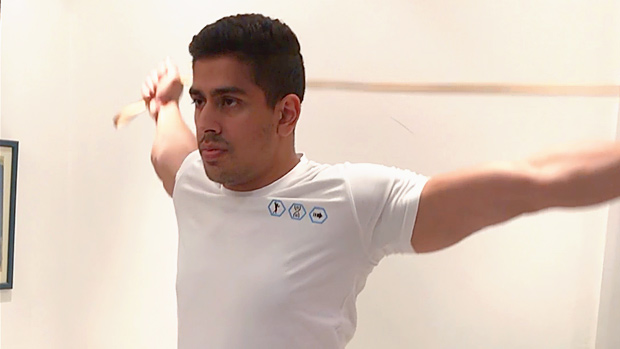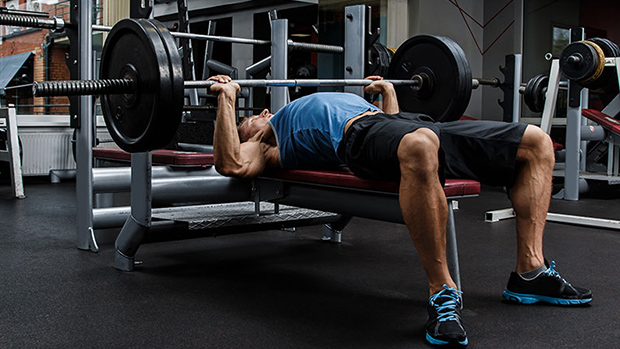Look around your gym. Most trainees lack the calf thickness to suspend a pair of double striped knee socks, let along balance out the size and symmetry of the lower leg. Now look in the mirror. Are you one of them? If so, you're seriously limiting strength, size, and symmetry with those 8" thin calves. The following article will cure your chicken calves and revolutionize ankle flexor training with a precise approach.
Support New Growth!
The lower body chain begins and ends with ankle strength. For example, as you initiate a deadlift the nerve impulse co-contracts the muscles of the toe and ankle flexors. This in turn radiates the muscles along the chain to the knee flexors and ends up in the lower back extensors. Simple observation will tell you that the distal chain link (ankle flexors) will likely fail first. Watching a trainee deadlift or squat barefoot reveals much of this ankle instability. The increasing popularity of the high tops and ankle and knee supports used to overcome this obstacle proves its necessity. Exercises that rapidly benefit from optimal ankle development include deadlifts, all types of squats, and even the bench press.
Beginners need calf strength to develop the lower body. Intermediate bodybuilders need to fix strength imbalances and advanced trainees need it to complete leg symmetry (a competitive edge). Additionally, the smaller your ankle circumference, the more likely you're unstable and the more strength specialization you'll need.
A study by Fry et al on the "Anthropometric characteristics as discriminators of bodybuilding success" using elite bodybuilders indicates that at the time of competition, calf circumference shouldn't vary too much more than one inch from upper arm circumference. (1, 2) The average calf thickness was 15" amongst winners and 14.75" for other competitors. A quarter of an inch means a lot!
Strength is also highly correlated to muscle cross-sectional area (C.S.A.). Anecdotally, one of my trainers was able to gain a fourth of an inch on his calves over a long weekend once he applied the following information!
Genetics are a Lame Excuse!
Surprisingly, the gastrocnemius and soleus are only two of six ankle plantar flexors and most trainees haven't learned how to differentiate them. Let me be blunt: if you lack calf development, you've either given up and neglect calf training or you simply haven't used the right approach. Don't use the excuse of "bad genetics"!
The big three plantar flexors – gastrocnemius lateral head (LG), gastrocnemius medial head (MG), and soleus (SOL) – have the most mass potential and share a common insertion at the Achilles tendon, yet they each have a very specific line of pull. According to a study by Signorile et al on the "Selective Recruitment of the Triceps Surae Muscles with changes in knee angle":
"The seated-calf raise shows heavy use of the SOL muscle and no use of the LG or MG. Standing calf raise, donkey calf raise, and hack calf raise all provide heavy use of the MG. The utilization levels of the LG varied with the exercise employed, showing no use during the donkey calf raise with the foot pointed forward or inward and moderate use when the foot was pointed outward. For the standing calf raise and hack raise, the LG did a moderate level of work regardless of foot position."
Other references indicate each muscle is affected and manipulated by knee joint angle, body angle, heel position, and contraction speed. With such a comprehensive joint system, sloppy technique, and a haphazard approach will yield poor results.
A Test
I'm finding that the trainees with higher gastroc insertions (you know, the ones blessed with explosiveness but who lack mass) are the ones preferentially using the "toe point" and not the heel raise. To test the toe point versus heel raise disparity, remove your shoes and perform a five-rep max machine calf raise with a straight knee. Use the toe point. In other words, flex and use the toes to grip and push.
Next, rest four minutes, unload 50% and repeat. This time, however, extended the toes away from the platform during the exercise. This will inhibit the toe flexors and force the work to be done primarily by the targeted "big three" ankle flexors. Most will note that they can't even initiate the load without the assistance of bending the knees, rocking forward or flexing the toes.
Another Test
Suffer from lateral knee pain when squatting or jumping? This common problem is resolved quickly by balancing out the "roll" and "rotation" plantar flexors. First, let's test them.
Belt out a few heavy reps on the prone leg curl machine and observe your foot position at the peak contraction. Does the foot on the side of your bad knee turn out and roll slightly? Or do you initiate a heavy rep by first flexing the ankle? Both situations indicate forefoot and ankle plantar flexor imbalances. Even if knee pain hasn't resulted, the lateral hip muscles are next up the chain and can take a blow, thus causing back pain. Whatever the end result, fixing this ankle imbalance can cure it and add an easy 50 pounds to your squat and deadlift.
Functional Anatomy: Ankle Plantar Flexors
Here's a crash course in the ankle plantar flexors we'll be attacking with the program outlined below.
Attached to the Heel (greatest size and strength potential)
Soleus
Gastrocnemius – medial head has largest mass potential, lateral head is more powerful
Plantaris
Attached to the Forefoot and Heel (ankle stabilizers, transfers force through foot, weakest link in development)
Tibialis posterior
Peroneus longus and brevis (weakest in four out of five trainees)
Attached to the Toes, Forefoot and Heel (intrinsic, proprioceptive and technical muscles)
Flexor hallucis longus
Flexor digitorum longus
The Functionally Correct Calf-Building Routine
This workout is designed to be performed four days per week for four weeks. Alternate day one and day two twice per week. This routine is to be performed prior to your regularly scheduled workout.
Day 1: Prime Movers Tri-Set
A1) Donkey heel raises, single leg – First, extend your toes upward, thus inhibiting them. Place your foot "ball" on a block or stair. Bend forward from the waist and support the upper body on a bench or elevated stair. The toes are placed below the hips, knees extended and buttocks slightly posterior of the ankles.
 |
From this point, contract and elevate the body from the heel (not the toes) and slowly lift to its end range. Next, lower the heel to the stretched position. For added resistance use a weighted dip belt strapped across the waist. Do a set, rest ten secoinds, and move on to A2.
Sets: 4
Rep progression:
Week 1: 10-12
Week 2: 10-12
Week 3: 4-6
Week 4: 3-5
Tempo: 313 (See FAQ if you're unfamiliar with tempo prescriptions.)
Rest: 10 seconds
A2) 45-degree leg press heel raises, mid-stance, feet pointed out – First, extend your toes upward, thus inhibiting them. Place your foot "ball" at the base of the leg press machine. The toes are placed anterior to the hips, knees fully extended and buttocks slightly posterior of the ankles, feet pointed out.
 |
From this point contract and elevate from the heels (not the toes) and slowly press to its end range. Next, lower the heels to the stretched position while still maintaining your extended toe position. Do a set, rest ten seconds, and move on to A3.
Sets: 4
Reps:
Week 1: 10-12
Week 2: 10-12
Week 3: 4-6
Week 4: 3-5
Tempo: 313
Rest: 10 seconds
A3) Seated heel raises – I like to do this one barefoot using a towel to soften the surface. This is in order to get the best "feel." First, extend your toes upward. Place the ball of your foot at the base of the seated calf raise machine, knees bent at approximately 100 degrees. From this point, contract and elevate from the heels (not the toes) and slowly press to the end range. Next, lower the heels to the stretched position while still maintaining your extended toe position. Do a set, rest 120 seconds, and repeat the tri-set three more times.
 |
Sets: 4
Reps:
Week 1: 10-12
Week 2: 10-12
Week 3: 4-6
Week 4: 3-5
Tempo: 313
Rest: 120 seconds
 |
Sets: 3
Reps all 4 weeks: 15-20
Tempo: 212
Rest: 60 seconds
Day 2: Stabilizer Drop Sets
A1) Low cable, plantar flexion and inversion – Attach the ankle attachment to a low cable machine. Line up standing or seated perpendicular to the line of pull. First, toe point and flex your ankle. Next, rotate your ankle from 12 o'clock (neutral) to 10 o'clock, while maintaining the ankle plantar flexion. Do a set, rest 30 seconds, and move on to A2.
 |
 |
Sets: 2
Reps:
Week 1: 10-12
Week 2: 10-12
Week 3: 4-6
Week 4: 3-5
Tempo: 101
Rest: 30 seconds
A2) Cross-under stepdowns – Stand slightly narrower than shoulder width on top of a 12" to 18" step or block. Make sure there's extra floor space on the sides. With one leg, step down and reach posterior-laterals across the body midline. Strike the ground with the toe. Next, push concentrically with the elevated foot so that the "crossed-under" foot can return to shoulder width position on the step. Do a set, rest 60 seconds, and repeat the two exercises.
 |
 |
Sets: 2
Reps:
Week 1: 10-12
Week 2: 10-12
Week 3: 4-6
Week 4: 3-5
Tempo: 101
Rest: 60 seconds
B1) Low cable plantar flexion and eversion – Attach the ankle attachment to a low cable machine. Line up standing or seated perpendicular to the line of pull. First toe point and flex your ankle. Next, outwardly rotate your ankle from 12 o'clock to 2 o'clock while maintaining the ankle plantar flexion. Do not rotate your knee! Do a set, rest 30 seconds, and move on to B2.
 |
 |
Sets: 4
Reps:
Week 1: 10-12
Week 2: 10-12
Week 3: 4-6
Week 4: 3-5
Tempo: 101
Rest: 30 seconds
B2) Wide lateral stepdowns – Stand slightly narrower than shoulder width on top of a 12" to 18" step or block. Make sure there's extra floor space on the sides. With one leg, step laterally, outside of hip width. Strike the ground with the flexed ankle of the free foot. Next, push concentrically with the elevated foot so that the "unloaded" free foot can return to shoulder width position on the step. Do a set, rest 60 seconds, and repeat the two exercises 3 more times.
 |
Sets: 4
Reps:
Week 1: 10-12
Week 2: 10-12
Week 3: 4-6
Week 4: 3-5
Tempo: 101
Rest: 60 seconds
Conclusion
Remember, alternate day one and day two twice per week for a total of four calf training session per week. Take before and after measurements and you'll be amazed at the size you'll put on in just a month!




